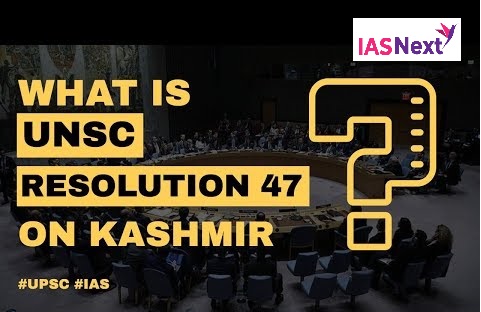CURRENT AFFAIRS
Get the most updated and recent current affair content on Padhaikaro.com
UN Resolution on Kashmir in 1947
- IAS NEXT, Lucknow
- 26, Mar 2022

Context:
There has been some debate on whether India chose the wrong path to approach the UN. In 2019, Home Minister Amit Shah said that had Nehru taken the matter to the UN under Article 51 of the UN Charter, instead of Article 35, the outcome could have been different.
Article 35:
Article 35 only says that any member of the UN may take a dispute to the Security Council or General Assembly.
Article 51:
It says that a UN member has the “inherent right of individual or collective self-defence” if attacked, “till such time that the Security Council has taken measures necessary to maintain international peace and security”.
Do you know about Resolution 47?
Resolution 47 of the UNSC focuses on the complaint of the Government of India concerning the dispute over the State of Jammu and Kashmir, that India took to the Security Council in January 1948.
- In October 1947, following an invasion by soldiers from the Pakistan Army in plainclothes and tribesmen, the Maharaja of Kashmir, Hari Singh sought assistance from India and signed the Instrument of Accession. After the first war in Kashmir (1947-1948), India approached the UN Security Council to bring the conflict in Kashmir to the notice of Security Council members.
Who were the UNSC members who oversaw the issue?
The UN Security Council increased the size of the investigating council to include six members along with permanent members of the UNSC. Along with the five permanent members, China, France, UK, US & Russia, non-permanent members included Argentina, Belgium, Canada, Colombia, Syria and the Ukrainian Soviet Socialist Republic.
What happened at the UNSC?
- India’s position was that it was ready to hold a plebiscite, a direct vote in which an entire electorate votes on a specific proposal, to know of the people’s desire and accept the results of the vote.
- Pakistan denied its involvement in the conflict and counter-accused India.
- In response the UNSC, under Resolution 39 (1948) stated “with a view to facilitating…the restoration of peace and order and to the holding of a plebiscite, by the two Governments, acting in co-operation with one another and with the Commission, and further instructs the Commission to keep the Council informed of the action taken under the resolution.”
- It also ordered for the conflict to cease and to create conditions for a “free and impartial plebiscite” to decide whether Jammu and Kashmir would accede to India or Pakistan.
What did the UNSC order Pakistan to do?
The UNSC ordered that Pakistan was to withdraw its tribesmen and Pakistan nationals who had entered “the State for the purpose of fighting” and to prevent future intrusions and to prevent “furnishing of material aid to those fighting in the State”.
It was also ordered Pakistan to cooperate with maintaining peace and order.
What did the UNSC order India to do?
The UNSC had a more comprehensive set of orders for India.
- It said that after the Pakistani army and tribesmen had withdrawn from the State and the fighting had ceased, India was to submit a plan to the Commission for withdrawing forces from Jammu and Kashmir and to reduce them over a period of time to the minimum strength required for civil maintenance of law and order.
- India was ordered to appraise the Commission of the stages at which steps had been taken to reduce military presence to the minimum strength and to arrange remaining troops after consultations with the Commission.
- Among other instructions, India was ordered to agree that till the time the Plebiscite Administration found it necessary to exercise the powers of direction and supervision over the State forces and police, these forces would be held in areas to be agreed upon with the Plebiscite Administrator.
- It also directed India to recruit local personnel for law and order and to safeguard the rights of minorities.
How did India & Pakistan react to the UNSC Resolution 47?
Both countries rejected Resolution 47.
Why India rejected?
India’s contention was that the resolution ignored the military invasion by Pakistan and placing both nations on an equal diplomatic ground was a dismissal of Pakistan’s aggression and the fact that the Maharaja of Kashmir, Hari Singh had signed the Instrument of Accession.
India also objected to the Resolution’s requirement that did not allow India to retain military presence which it believed it needed for defence.
The Resolution’s order to form a coalition government, would also put Sheikh Abdullah, the Prime Minister of the Princely State of Jammu & Kashmir, in a difficult position.
India also believed that the powers conferred on the Plebiscite Administrator undermined the state’s sovereignty. India also wanted Pakistan to be excluded from the operations of the plebiscite.
Why Pakistan rejected?
Pakistan on the other hand, objected to even the minimum presence of Indian forces in Kashmir, as allowed by the resolution. It also wanted an equal representation in the state government for the Muslim Conference, which was the dominant party in Pakistani-held Kashmir.
Final outcome:
Despite their differences with the provisions of Resolution 47, both India and Pakistan welcomed the UN Commission and agreed to work with it.